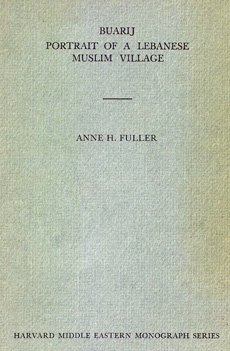| Éditeur : Harvard University Press | Date & Lieu : 1963, Massachusetts |
| Préface : | Pages : 98 |
| Traduction : | ISBN : |
| Langue : Anglais | Format : 140x210 mm |
| Thème : Général |
|
Présentation
|
Table des Matières | Introduction | Identité | ||
 Buarij: Portrait of a Lebanese Muslim village On the eastern slopes of the Lebanon Mountains, which run parallel to the Mediterranean Sea and form a distinguishing mark of the country, from the steep slopes of Mt. Knisseh at an altitude of four thousand feet, breaks a spring of water, neba asal, or "spring of honey" so called because of the sweetness and freshness of its flow. Lesser springs lie near it. Close to the waters is an Arab Muslim village, its nearer fields and stand of poplars fed by diverted streams. Here high on the eastern mountain slope, facing the interior of the country, a peasant people have their home and gain a living from the soil. The spring waters flow downward to the plain, a thousand feet below, or to that elevated tableland, the Beqaa, which divides the Lebanon mountains from the more easterly and parallel Anti - Lebanon range. It is this stretch of territory of downward mountain slope, of width of plain, and face of further mountain range that village houses overlook. The village itself is the highest settlement on the mountain side. It forms the apex of a watered triangle which becomes more populated as the foothills and region... | |||||
| PREFACE Though the villagers were accustomed to the few Beirut Muslim summer people who stayed in Buarij, no foreigner had before resided in the community. But since foreigners summer in villages on the opposite western slopes of the Lebanon range overlooking the Mediterranean Sea, the notion of a resident foreigner was not entirely without precedent. Through these families I came to know their relatives and neighbors, spending much time in homes, going into the fields with groups, or accompanying them to neighboring towns, to the water mill on the plain below, or to distant villages from which wives had come into Buarij. In the winter of the year many days were spent with herdsmen families who had gone to the coast land, they sharing their food with me in front of their herdsmen's caves and huts. Information was collected largely by an informal rather than a formal method — by listening to village talk and participating in village affairs. By this means, I was accepted more readily, since the villagers tended to associate direct questions, especially involving statistics or any numerical data, with the unpopular tax collector or other official intruders from outside the village world. All village persons I came to call by kinship terms. The girls were "sisters" the boys "brothers," the grown men "paternal uncles," and the elders "grandfather" and "grandmother." In turn I was treated almost as kin. Living within the community, I adhered to those dictates governing the deportment of an unmarried Muslim woman. From the villagers, increasing loyalty was received. Towards them, I had equal loyalty. In 1945 during World War II, I managed to return for a day to the village. Meanwhile, the British had evicted the Vichy French from the country. On the main Beirut-Damascus highway were pillboxes and entrenchments. But the village itself had remained untouched. The villagers, however, were full of war talk. From their high location they had witnessed air battles above the plain and the passing of troops, both British and Vichy French, on the main routes of communication. But they themselves had not fared badly. There had been construction work on the roads, and the British had taken over large areas of the plain below for the growing of foods for their troops in the Middle East theater. This had given village men increasing work. The village men at this time were more adequately clothed than in 1937, largely in British army goods. They said they came by these through means best known to themselves. Because the villagers had been cut off from the towns and from itinerant peddlers, there was a marked revival in certain village crafts, particularly in the spinning and knitting of village wool. But Buarij in its physical appearance remained much the same. It was in political consciousness that the village had changed most. Lebanon's freedom as an independent nation had been proclaimed. The young men talked much of the future of the country and of the larger Arab setting. The former watchman of the village, a forceful figure, was now a gardener at the American Legation in Beirut. The best place for work was in the cities, he said. But he would return to the village for the summer months. The women as before remained concerned largely with events near at hand. They regretted that they and others from the neighboring villages had not attended the spring festival, badly disrupted by the war years. From a pair of army trousers hanging on the wall of a house, the legs knotted to form a sack, walnuts were given me. Two eggs were fried in sheep's fat. Later, I turned down the village road towards the highway. Since then I have not seen the peasants of Buarij, who were my friends and whom I came to hold in loyal affection. A. H. F. Cambridge, Massachusetts | ||||